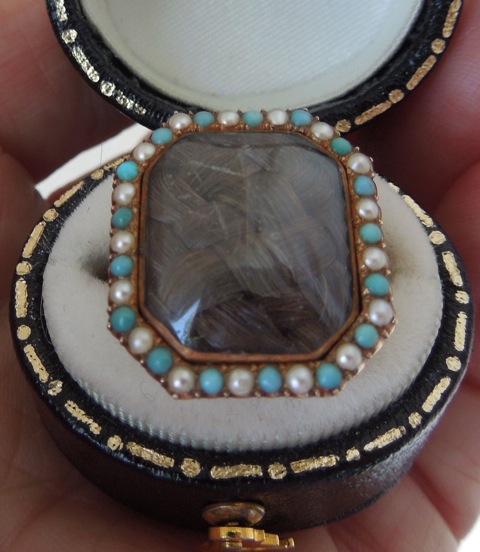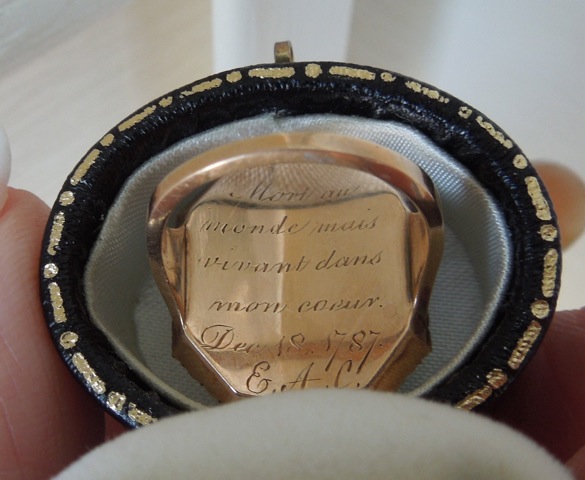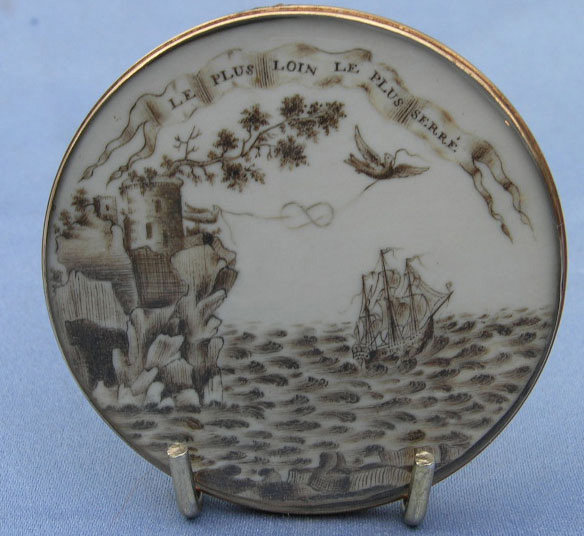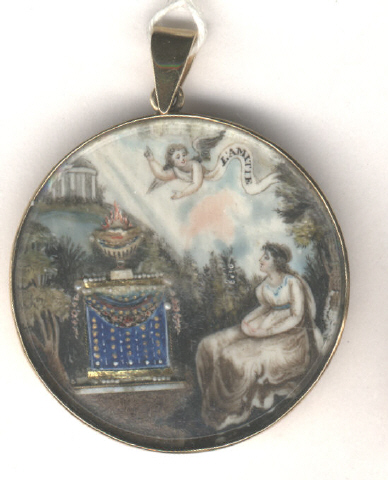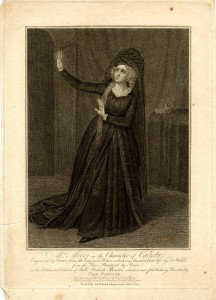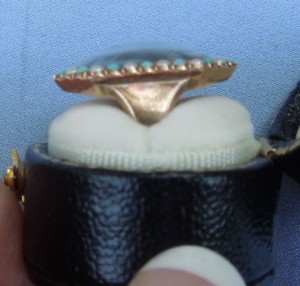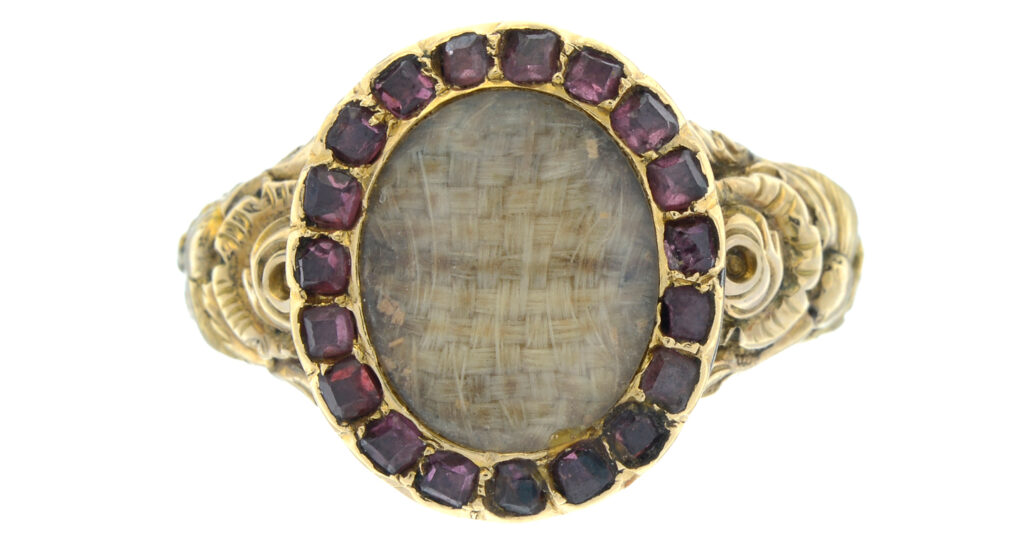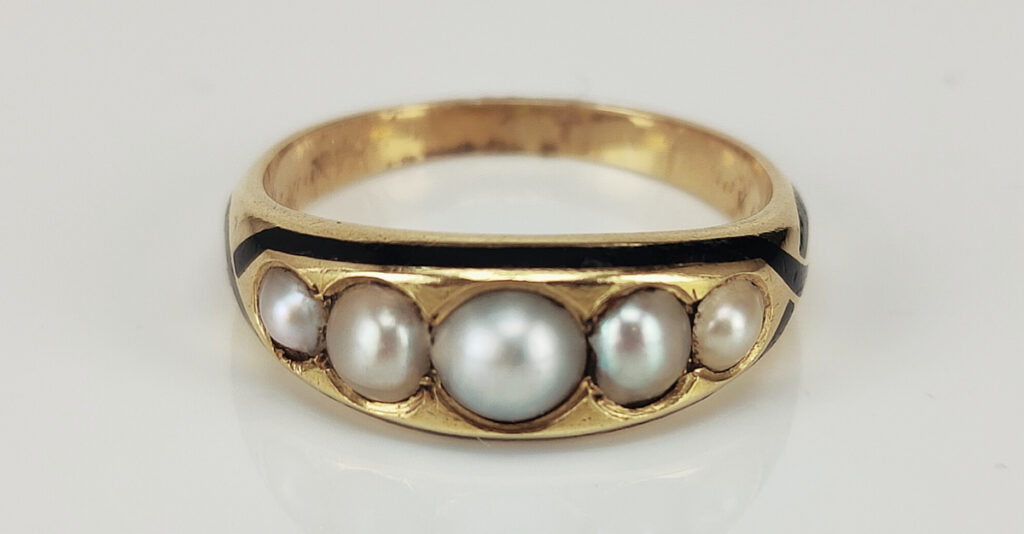“Dead to the world” French Mourning Ring, December 18, 1787
Historical sentimentality, regardless of era, culture or status still relies on the very nature of love and loss. A relationship is a set of mutually shared experiences and these experiences imprint the moments of love and sadness that are imprinted on a person. When a ring such as today’s French mourning ring appear, the sentiment is just as profound as it was back then. “Dead to the world, though living in my heart” is a form of personal poetry that was worn against the skin and resonates the nature of love for this one person.
Taken into context with the massive cultural shift within the society that created it, the sentiment, the design, the materials and the construction are even more personal. This ring was created at a time just shy of a year away from the French Revolution of 1789. A society physically challenged by the American Revolution, the Seven Years’ War and through thought by the Enlightenment, French liberal ideals based themselves around the identity of the self and what the concept of that meant in society, politics and religion.
Yet, here we have a ring which doesn’t adorn itself with the affectations of the popular Neoclassical allegorical depictions of romance in death or love. There is no weeping woman, willow, urn or plinth. The fact of the self is retained through the hair of the person who is being mourned, surrounded by turquoise and pearls, as a simple statement of love that becomes fashion.
Friendship and piety are the main elements seen in Neoclassical French mourning and sentimental pieces, with that strong relationship status becoming the ideal of which to represent the self in society. Through this ring, we shall explore the messages of mourning and fashion which bought into context the romantic ways of love in jewellery.
Poetry of the Sentiment in Mourning Jewellery
Writing a sentiment within a ring is as old as the wearing of finger jewellery itself. Since written language could depict shapes identified as loving messages, the connection of one person to another was reflected in jewellery. To wear something of a loved one that resonates love is essential to the very fabric of mourning and sentimentality, and by the time of mass produced jewellery which could allow for sentiments to be written after purchase of the ring. Post 1680, the mourning rings produced could accommodate the growing requests for mourning rings to be given out at funerals. Robert Walpole, Earl of Oxford, died in 1700 and bequeathed 72 rings at £1 each to friends and family, which shows just how early the practice was becoming part of the cultural lexicon. 72 rings is quite a number, considering the size of immediate family, the high mortality rate and the impact that gaining a ring would mean in society. Social status was important for the aristocracy and presenting a jewel that contained the memory, even as a token, was ideal for the visibility of the family.
The ring displayed in today’s article is more personal in its sentiment.
There is an immediate reflection of the status of the relationship. Indeed, the statement of death is written in a way that shows the impersonal nature of the relationship, as the person is ‘dead to the world’, but retains the personal in ‘living in my heart’. There is no direct connection of a familial relationship in the piece, without a sentiment of being married or related through blood. In this, there is a strong current of the values of the time, being part of the humanist view that valued the friendships made of the time. However, as there is no full relationship denoted, any basis of relationship value is supposition. But, that is what is so special about this ring; it’s a cultural piece based around its contemporary values. It has all the elements of beauty for its time, with the influence of the pearls and turquoise, but uses the hair as its primary message to the viewer.
Pearls and turquoise, being the obvious decorative element in this piece, were used in the ordinary stage of mourning and also were a status symbol. Discovery and trade led to the desirability of pearls, particularly from medieval and Elizabethan times. ‘Oriental’ pearls, originating from the oyster family, were the most desirable due to their lustre, which pearls from freshwater mussels and conch shells do not have. The Oriental pearls were bought to Europe form the Persian Gulf by caravan traders. As the 1780s and 1790s defined the popularity of pearls for their beauty and status, this ring denotes that in true form.
From what can be seen in this sentimental miniature depiction is the confluence of different sentimentality to show what the relationship status was. Symbolism and beauty are two words to describe this French piece. The two birds (winged souls) tying together the knot of eternity and love as the ship is sailing away from the castle on top of a cliff face. The boat can be taken as a literal interpretation of sentimental distance, or as the passage of a soul towards the afterlife, however as the boat shows its passage towards the horizon, then one can expect that the symbolism falls into the latter. When combined with the eternity knot, the sentiment of love shows a love forever unbroken despite any figurative distance.
‘United by love’ is what the message of this heart pendant conveys, with its awkward integration of language within the Rococo ribbon elements. Much of this is due to the creation of the piece, with it’s French origins in following the mainstream fashion of the time. The Rococo style was driven by decorative arts movements in Paris, Prague, Lisbon, Vienna and Italy, then popularised by Louis XIV and XV (respectively). Taking the Baroque style and adding a naturalist, overly ornate elegance to embellish it, seeded its way through furniture, architecture, design and art. Here, with this pendant, we can see the separation of a formal, unified pendant style (such as the oval/rectangular shapes of the late 17th and early 18th century), turning the elements into the elaborate ribbon with its white enamel message. Garnets, particularly, were becoming the popular gem of choice for many memorial and sentimental jewels. Their use, from a symbolic point of view, was to enhance the meaning of the jewel they were set in, which was facilitated by the growing language of gems to relate to their symbolism. As the stages of mourning became indoctrinated, the use of gems for their colours and meaning became more and more important as a personal representation of mourning in fashion.
The utilisation of the sentiment, ‘united by love’ as a token of bequeathment creates the statement of transcending fashion into love jewellery. Take this into context with today’s ring and see the statement of ‘living in my heart’ seem to far distinct from the message of the word ‘’love’. Love, being the central theme, is established in this heart pendant, but not so clearly defined as the ring itself.
Friendship, as a token of love from a non-familial relationship, is still as strong as the immediate status of the relationship in anyone who wore these jewels. Within the sentiment of the ring that is the focus of this article, the ‘living in my heart’ sentiment is the key to understanding just what a relationship was. It was not simply the physical connection of the person from marriage or through being a brother or a sister, but the concept of the person as being loved. Friendship is just as powerful a reason to retain a token of a loved one and to wear it, beyond the cultural needs for being in mourning. Indeed, the family retained the three stages of mourning for the person, with peripheral relationships having the affectation of mourning costume, but not the adherence to it after a month or so (depending on the time of Court mourning mandates in the 18th and 19th centuries). Hence, a ring with a strong dedication, or a pendant such as this, focus of the humanist elements, developed through the Enlightenment, that are more focused upon what love between two people is and can be represented by, rather than being an official indoctrination through state and god.
If any mourning depiction was to use every element of its strength to convey classical depictions of mourning, this miniature would be it. From the fashion of the lady, to the design and high-relief construction of the eternal flame urn on blue enamel plinth, no expense has been spared to the detail in the mourning elements. What is most interesting is the written sentiment. Once again, friendship is the identifier for the status of the relationship, not mother, daughter, husband or wife, but ‘friend’. It is enough to denote in society that a person was in mourning for another and fashionable to wear in public.
Written Sentimentality
Posie rings, otherwise known as ‘poesy’, ‘posy’ or ‘posey’, are one of the primary catalysts for the mourning and sentimental rings that generated their own industry post 1680.
Those written in English suffered from the lack of standardisation of the English language. With the written reliance on Latin previous to the dictionary in 1755, posie rings are a remarkable time capsule for phonetically capturing their surrounding language in a jewel. From a status perspective, this utilisation of language is accessible to a strata of society that didn’t have the luxury of formalised education, opening up sentimental jewels to new levels of society. Basic sentiments of love etched into silver and gold bands could now be given as a secret love token for a growing middle class. In rings previous to the 16th century, more common would be the inscriptions written in French, Latin and Norman French.
Chapbooks, pamphlets containing popular literature, were a popular source for many of the sentiments written inside the posie rings. These cheap pamphlets grew in popularity, as they were sold cheaply (commonly a penny or halfpenny) and contained many popular ballads from the time. This pre-dates mass produced media of the early 19th century, when steam presses led to the rise of cheap newspapers. From the mid 16th century, these cheap and crudely produced booklets contained relevant popular content that varied from entertainment to political and religious content. Here, the relation of the ring to the popular literature is the key factor in understanding just how the posie’s relation to society. They were jewels that could be for the commoner, but also transient as a style of love token through society because of their simple statements.
A Window into Woven Hair
Woven hair in Neoclassical jewels has its continuity from the 17th century, when hair was woven and placed under crystal. This was often set above material or vellum.
Which is why this ring wasn’t a cultural shock for its time. Displaying the hair of a loved one in popular fashion was typical and a standard of love tokens. Furthermore, it was cheaper than having a miniature display all the elements of love, so a ring like this could be made in bulk and then tailored to the buyer’s requirements. Hair could be placed underneath domed crystal or glass, with a sentiment written on the reverse.
The custom of giving and receiving hairwork can be for mourning or sentimental purposes, but its singular theme is love. Rules apply in the giving of hairwork, it can be a grand statement of affection between two people and, in the past, there were rules to abide by. An unmarried girl could receive nothing from an unmarried man unless she was betrothed to him; however, a girl could give an admirer a lock of hair at his request and accept one, provided that neither was set in a jewel.
Trade of hair between family members was common, as was exchange of hair during the departure of a loved one for a period of time. Mourning pieces were often referenced in a will, with money left allocated for the chosen pieces. This could range from hairwork in rings to lockets. During the 19th century and the mass hairworking industry, inexpensive bands of woven hair (not always of the deceased), with pinchbeck fittings were a popular choice. Memorial pieces could also be commissioned by family members, in the shape of bracelets, earrings or whatever the wearer chose. This custom can be traced back to the late 16th / early 17th centuries, with notably William Shakespeare allocating mourning rings in his will (1616). There are many different reasons for the creation of hairwork jewellery and memorials, but at their inception, it is about love.
Prior to the rise of the hairworking industry and its prominence in mainstream jewellery, gifts of hair were considered tokens of affection and love between two people. Bury refers to The Relique (or The Relic) by poet John Donne (1571-1631) and its very early reference to a hair bracelet:
“When my grave is broke up againe
Some second ghest to entertaine,
(For graves have learn’d that woman-head
To be to more than one a Bed)
And he that digs it, spies
A bracelet of bright haire about the bone,
Will he not let us alone,
And thinke that there a loving couple lies”
Donne speaks in metaphysical terms about the unifying nature of spiritual love, as when he and his lover are dug up, they remain the symbol for holy and eternal love. From this, the poem is an excellent perspective on the sentimentality of hairwork at the turn of the 17th century. Wearing hair was an encompassing symbol of union and love between two people.
Donne wasn’t unique in his wearing of a hair bracelet, however, as Count de Grammont viewed several people wearing hairwork bracelets in the Court of the restored Charles II, circa 1660. This ties in with the rising prominence of other sentimental jewellery at that time. From love tokens, such as posy rings, to hair woven under crystal in slides, brooches, rings and other forms of jewellery, sentimental jewellery was rapidly evolving over the 17th century. Within these forms of sentimental jewellery, the use of hair became ever more prominent. Another example from 1647/8 of the popularity of hairwork within mainstream culture can be seen in Mary Varney’s letter to Sir Ralph Varney, asking to send locks of their daughter’s hair “to make bracelets? I know you could not send a more acceptable thing than every one of your sisters a bracelet”. At the time, Ralph was living in exile in France during the Protectorate. Hair tokens within families was the more common practice, but as jewels grew as a social device, so did their nature as a personal statement.
Royalty at the time also propagated the hairwork custom, exemplified by Queen Henrietta Maria (1609-69) wearing a hair bracelet as a token of affection. Factors such as these laid the groundwork for the hairworking industry that was to come. As discussed by Bury, in 1685 mourning lockets “are at least £6 in the making”. This was an extravagant price for a slide or locket of the time, leading to an increased allowance for mourning jewels in wills.
Evolution of hairwork over the 18th century was rapid and on a large scale. Jewellery changed with fashion, as the two are intrinsically linked. Smaller styles of jewellery that had grown with the 17th century began to disappear and by around 1760, and new, larger forms became the standard. Hairwork over this time was becoming more affordable and a craft which ladies could do at home (though not to the extent of the 19th century). A letter from the Duchess of Portland to Miss Catherine Collingwood, written on December 1st 1735, suggests that ladies were in the habit of working the hair, leading the goldsmiths to provide the gold settings. Pieces made to order became more and more popular in the first half of the 18th century, with lockets (especially in the popular heart motif) containing hair becoming increasingly common. As larger jewellery with glass replaced faceted crystal, simple weaves of hair could be placed underneath, without it being a speciality craft or as expensive.
By the 1760s, hair was reintroduced in mass produced memorial medallions and lockets (in England and on the Continent), as it was mixed in with sepia and painted on to ivory. Sepia / hair painting is a typical and very popular method from the 1760s to around 1810, with many pieces being a standard style (sometimes chosen from a hairworker’s catalogue) and tailored to the individual with the appropriate name and inscription. Chopped hair also was a common feature of memorial art on ivory (sometimes vellum), with scenes / symbolism assembled with hair and glue. Hair weaving was also in high demand, with everything from brooches to miniatures holding a compartment in which to place the woven hair. Hair weaving was becoming far more intricate, with hair being entwined with pearls and gold.
Fashion in the Late 18th Century
Finally, the fashion of the time was the grand statement with which the ring was worn. Why was sentimentality so united with fashion that a ring with hair in a display so large accommodated by society?
Post 1760, the Neoclassical movement had crept into the previously fashionable Rococo style of costume fabrics. Elaborate Rococo floral motifs moved to simple stripes or smaller motifs. Side hoops were discarded and lighter silks and cotton was introduced, with much influence being from the aristocracy. Marie Antoinette was painted in La reine en gaulle, by Elisabeth Vigée-Lebrun, 1783, introducing a new style that reflected the peasantry, showing a muslin chemise, straw hat and belt at the waist.
The 18th century welcomed in greater convention for mourning fashion and began to see the rise of the mourning industry. This became so much so that mourning dress was becoming desirable and the difference between mourning and non mourning dress was narrowing. Much of the fashion in this century was dictated by the fabric rather than the cut, and the silk industries in France and England held major influence on mourning wear because of this. It was Ordre Chronologique des Deuils de la Cour, (1765) where details of Court mourning in France were published, giving precise tailoring instructions. From their first days in mourning, men were permitted to appear in Court, unless it was after the death of a parent from whom they had received inheritance.
Widows had to wait one year and six weeks, with the first six months in black wool. Lord Chamberlain and Earl Marshall both ordered shorter periods of mourning in France and England respectively.
As in the 17th century, black and plain were required. Bombazine dresses trimmed in black crape, black silk hoods and plain white linen were worn with black shammy leather shoes, glove and crape fans. Jewellery was not permitted. Second mourning consisted of black dresses, trimmed with fringed or plain linen, white gloves, black or white shoes, fans and tippets and white necklaces and earrings as necessary. Grey lusterings, tabbies and damasks were acceptable for less formal occasions.
Ordre Chronologique des Deuils de la Cour was specific and influential enough to decide upon women’s fashions, as. It was specific enough to specify that; ‘dress was cut with a train and turned back with a braid attached to the side of the skirt, which was pulled through the pockets.’ This is where the overskirt is turned to the back and lifted up, revealing the petticoat underneath, called; robe retrousee dans les poche, the centre front robings were joined with hooks or ribbons. Cuffs were cut with one fold and deep hems, the waist was held in place by a crape belt that was tied on. This left two ends hanging down to the hem of the skirt.
A woman’s accessories were a crape shawl, gloves, shoes with metallic bronzed buckles, a black woollen muff and a black crape fan. Head dresses of black crape and white batiste were referenced. For much of the century, however, ‘paniers’ were fashionable, but in the French style, with loose pleating falling from the shoulders to the back. The English manner of this was with the back pleats stitched down as far as the waistline. Also popular were lace ruffles at the neck and the cuff, embroidered stomachers, silver gilt lace, appliqué work and small aprons. None of these were permitted for mourning wear. Mourning wear for women still remained consistent in that it remained plain, black or sometimes white fabric.
Relationships Never Change
The status of relationships, regardless of what the popular fashion is at any given time, still remains the same. This ring retains all the love for the person who wanted to remember their loved one at a modern time of change. A person of non-aristocratic status could display their love for another through less affluent jewels and the introduction of simple weaves of hair. Utilising gems, the status of a piece could be shown with materials flanking the hair, making the piece fashionable and desirable, but also never letting go of what the piece truly means.
In this ring, love is its status and for as long as it survives, so will its memories.




